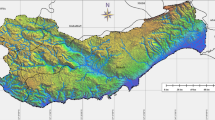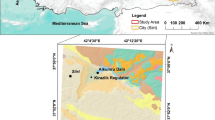Abstract
Landslides are presented in various types; some of which are unique or completely different from those in other countries due to geological conditions in China. Baoji City in Shaanxi Province, as a study area, is intensely affected by loess slope movements, triggered by directly intensive rainfall and indirectly by human activities. This paper provides a framework for the development of a Geographical Information System-based procedure to qualitatively assess landslide risk at a medium scale of 1: 10,000. For environmental factors affecting landsliding in the study area, erosion of river made great contribution to the occurrence of paleo-slides and old slides, while rainfall and human activities were triggers for the presence of recent landslides. The qualitative susceptibility assessment was studied in terms of slope instability using slope units, and regional-scale hazards were then analyzed by incorporating the type of landslides with susceptibility. From the landslide susceptibility analysis, almost 75% of slopes were classified as high susceptibility, in which five slopes were recently reactivated. It was noted that only 6 old landslides were categorized into high levels of hazard in case of rainfall, after assessment by combining susceptibility with types of landslides. Finally, landslide risk analysis was qualitatively made in an automatic way within the GIS, crossing the hazard map and the map of consequences to property.











Similar content being viewed by others
References
AGS (2007) Practice note guidelines for landslide risk management. Australian geomechanics society landslide taskforce landslide zoning working group. Aust Geomech 42(1):63–114
Catani F, Casagli N, Ermini L, Righini G, Menduni G (2005) Landslide hazard and risk mapping at catchment scale in the Arno River basin. Landslides 2:329–342
Derbyshire E, Wang JT, Meng XM (1999) A treacherous terrain: background to natural hazards in northern China, with special reference to the history of landslides in Gansu Province. In: Derbyshire E, Meng XM, Dijkstra TA (eds) Landslides in the thick loess terrain of north-west China. Willey, England, pp 11–18
Feng XJ, Li ZS, Song LS, Geng DY, Wei QK, Bruckl E, Chwatal W, Parotidis M (2003) Seismic exploration of Bojisan landslide in Baoji. Chin J Hydrogeol Eng Geol 4:55–58 (in Chinese)
Galli M, Guzzetti F (2007) Landslide vulnerability criteria: a case study from Umbria, Central Italy. Environ Manag 40(4):649–665
Guzzetti F, Carrara A, Cardinali M, Reichenbach P (1999) Landslide hazard evaluation: a review of current techniques and their application in a multi-scale study, Central Italy. Geomorphology 31:181–216
Hu HT, Xiang SJ, Wang QF, Ling PQ, Chen X (1965) The characteristic constitution and structure of landslides in western Kwangchung region and analysis of their stability. Acta Geol Sinica 45:436–458 (in Chinese)
Ko Ko C, Flentje P, Chowdhury R (2004) Landslides qualitative hazard and risk assessment method and its reliability. Bull Eng Geol Environ 63:149–165
Liu CZ, Zhang MX, Zan ZS, Li SS (1998) Research on the stability of Dijiapo slope in Baoji City. Chin J Eng Geol 6:103–113 (in Chinese)
Meng XM, Dijkstra TD, Derbyshire E (1999) Loess slope instability. In: Derbyshire E, Meng XM, Dijkstra TA (eds) Landslides in the thick loess terrain of north-west China. Willey, England, pp 175–181
Pye K (1995) The nature, origin and accumulation of loess. Quat Sci Rev 14:653–667
Remondo J, Bonachea J, Cendrero A (2008) Quantitative landslide risk assessment and mapping on the basis of recent occurrences. Geomorphology 94:496–507
Romeo R, Floris M, Veneri F (2006) Area-scale landslide hazard and risk assessment. Environ Geol 51:1–13
Schuster RL (1996) Socio-economic significance of landslides. In: Turner AK and Shuster RL (eds) Landslides: investigation and mitigation. Transportation research board—national research council, special report 247, pp 12–35
Sterlacchini S, Frigerio S, Giacomelli P, Brambilla M (2007) Landslide risk analysis: a multi-disciplinary methodological approach. Nat Hazards Earth Syst Sci 7:657–675
The Third Geological Survey of Shaanxi Bureau of Geology and Mineral Resources (1999) Specification on the geological maps in Baoji City. Unpublished (in Chinese)
UNDRO (1979) UNDRO United Nations Disaster Relief Organization, Natural disasters and vulnerability analysis, Geneva, report of expert group meeting
Van Westen CJ, Castellanos E, Kuriakose SL (2008) Spatial data for landslide susceptibility, hazard, and vulnerability assessment: an overview. Eng Geol 102:112–131
Varnes DJ (1978) Slope movement types and processes. In: Schuster RL, Krizek RJ (eds) Landslides analysis and control. National Research Council, Transportation Research Board, Washington, pp 11–33
Zhang DX, Wang GH (2007) Study of the 1920 Haiyuan earthquake-induced landslides in loess (China). Eng Geol 94:76–88
Zhang AL, Yang ZT, Zhong J, Mi FS (1995) Characteristics of late quaternary activity along the southern border fault zone of Weihe graben basin. Quat Int 25:25–31
Acknowledgments
This research was supported by funding from National Natural Science Foundation of China (NSFC) (No. 40772170) and Key Program of Natural Science Foundation of Hubei (2009CDA007). Partial funding support was acknowledged with thanks from Huazhong University of Science and Technology (Project No. 2010MS057).
Author information
Authors and Affiliations
Corresponding author
Rights and permissions
About this article
Cite this article
Wang, H.B., Wu, S.R., Shi, J.S. et al. Qualitative hazard and risk assessment of landslides: a practical framework for a case study in China. Nat Hazards 69, 1281–1294 (2013). https://doi.org/10.1007/s11069-011-0008-1
Received:
Accepted:
Published:
Issue Date:
DOI: https://doi.org/10.1007/s11069-011-0008-1




